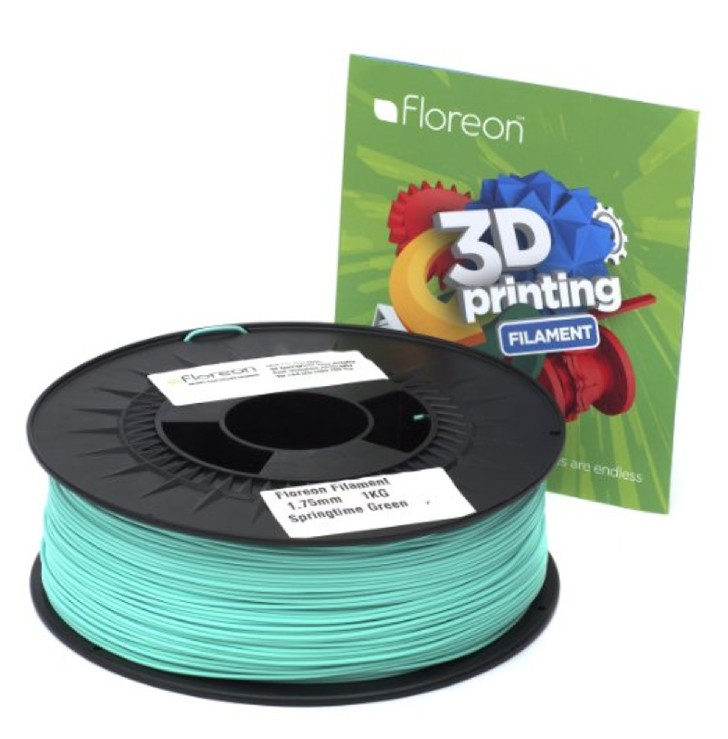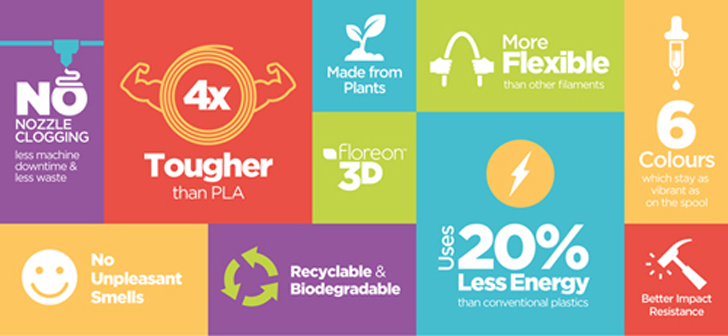Another materials company has just entered the 3D printing market with a new PLA filament it claims to be “four times stronger than standard PLA” – something that may need to be confirmed by an independent consultant, such as 3D Matter. The company, Floreon, is a UK bioplastics firm that has, today, released their Floreon3D filament in six colors on Amazon.
Floreon3D is actually the filament brand of Floreon Transforming Packaging Ltd, a company that is working to replace the oil-based plastic currently used for packaging with its own Floreon PLA material. Floreon is headed by CEO Shaun Chatterton, also the CEO of CPD plc, a large independent distributor of cleaning and hygiene products. The firm’s technical director is Sheffield University PhD Dr. Andrew Gill and Floreon also has Dr. John Williams, the former head of materials at the UK’s National Centre for Renewable Technologies (NNFCC), on their board. Now that the company has been producing its PLA in other avenues, it has turned to 3D printing. Producing Floreon in a variety of grades, from a general purpose grade to a material suited for injection molding, Floreon 3D is the company’s Floreon 700 3D printing grade bioplastic, a PLA deemed just a step below their 800 injection molding type.

I’ve asked for more information from the company regarding how their PLA is tested to demonstrate these claimed qualities, but Floreon is already making partnerships in and outside of the 3D printing industry. With ties to the Sheffield and Hull Universities, Floreon can boast its academic partners as proof of their material’s quality. They’ve also already begun teaming with those in the 3D printing space, specifically modular 3D printer startup NFire Labs, who will be shipping Floreon filament with their printers (as evidenced in the video below).
To test these claims, we’ll have to hear from the community. Now that Floreon3D filament is on Amazon, there will likely be some customer reviews. Or, you can purchase the material yourself and tell the world how you feel!
Update 7/3/2015: I’ve just heard back from the company regarding testing their PLA. Floreon tells me that they’ve performed internal and independent testing through Smithers Rapra. Smithers Rapra found, based on ISO 527-2 standards, the tensile strength to be 63 MPa, while Nothced Izod tests, based on ISO 180/1A, determined the impact strength to be 3.7 kJ/m^2. In house, the company performed falling dart impact resistance tests using sheets of Floreon compared to standard PLA 0.7 mm thick, relying on the ISO 6603-1/A standard. They determined that the impact resistance of Floreon was E50 1950 mJ, compared to standard PLA’s 490 mJ. The elongation at break tests, ISO 527-2, showed Floreon to achieve 70%, while standard PLA only reached 12%.
The company added, “Please note that these are guideline figures only and throughout the development phase we’ve made various tweaks to the formulation to enhance performance and processing window. Actual results will be influenced by print temperature and other processing factors.”




